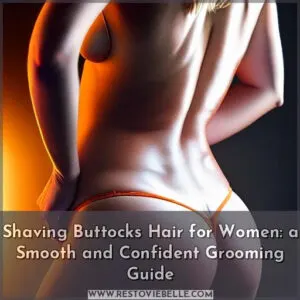This site is supported by our readers. We may earn a commission, at no cost to you, if you purchase through links.

Start by removing makeup with oil cleansing to dissolve stubborn formulas, then follow with a gentle cleanser suited to your skin type.
Apply cleanser with upward circular motions for 30-60 seconds, focusing on your T-zone and jawline. Rinse with lukewarm water and pat dry with a clean towel.
Cleanse twice daily—morning and evening—but avoid over-washing, which strips natural oils. Skip daily cleansing wipes since they can irritate skin.
The secret lies in being gentle yet thorough, treating your skin like silk rather than sandpaper for that coveted glow.
Table Of Contents
- Key Takeaways
- Essential Steps for a Proper Face Cleansing Routine
- How Often Should You Clean Your Face?
- Selecting The Ideal Water Temperature for Washing
- Tools and Accessories for Effective Face Cleaning
- Natural Ingredients for DIY Face Cleansers
- Exfoliation: How to Incorporate It Safely
- Post-cleansing Skincare: Toners and Moisturizers
- Common Face Cleaning Mistakes to Avoid
- Adapting Your Cleansing Routine for Seasonal Changes
- Frequently Asked Questions (FAQs)
- How do you clean your face?
- Should you wash your face every day?
- How do I cleanse my skin?
- What should I do if I don’t wash my face properly?
- How can I wash my face without face wash?
- What is the best way to clean your face?
- How to clean your face properly at home?
- What is the best way to deep clean your face?
- What is the best thing to keep your face clean?
- How can I clean my dirty face at home?
- Conclusion
Key Takeaways
- Cleanse twice daily with lukewarm water – You’ll want to wash your face morning and evening using gentle, upward circular motions for 30-60 seconds, then pat dry with a clean towel
- Choose the right cleanser for your skin type – You should use foaming cleansers with salicylic acid for oily skin, cream or oil-based formulas for dry/sensitive skin, and mild gel cleansers for combination skin
- Remove makeup first with oil cleansing – You’ll get better results by using oil cleansing or micellar water to dissolve stubborn makeup before following up with your regular cleanser
- Be gentle yet thorough – You shouldn’t over-wash or scrub harshly, but focus on problem areas like your T-zone and jawline while treating your skin like silk rather than sandpaper
Essential Steps for a Proper Face Cleansing Routine
Establishing a proper cleansing routine forms the foundation of healthy skin care at home.
You’ll achieve better results by following four essential steps that work together to remove impurities while protecting your skin’s natural barrier.
Removing Makeup Thoroughly
Your makeup acts like a stubborn house guest that won’t leave without proper encouragement. Makeup removal requires patience and the right techniques to protect your skin’s delicate barrier while achieving a truly clean face naturally.
Makeup clings to your skin like it owns the place—gentle persistence wins the removal game
Follow this essential face wash routine for thorough removal:
- Start with oil cleansing to dissolve waterproof formulas effectively
- Apply micellar water using flat cotton pads for gentle lifting
- Try makeup dissolvers for stubborn eye makeup areas
- Practice double cleansing with oil followed by water-based cleanser
- Skip cleansing wipes daily—they can irritate sensitive skin
This facial cleansing foundation sets you up for healthier, glowing skin.
Choosing The Right Cleanser for Your Skin Type
Selecting the right cleanser transforms your skin care routine into a powerful ally for healthy, glowing skin.
Understanding different cleanser types and conducting proper skin analysis helps you identify custom solutions that work.
| Skin Type | Recommended Cleanser |
|---|---|
| Oily/Acne-prone | Foaming cleansers with salicylic acid |
| Dry/Sensitive | Gentle formulas like cream or oil-based |
| Combination | Mild gel cleansers or micellar water |
| Normal | Natural face wash with balanced ingredients |
Product ingredients matter—avoid harsh surfactants that strip natural oils.
The best face cleanser respects your skin’s pH while providing effective facial cleansing without irritation.
Using a foaming face cleanser can be particularly beneficial for certain skin types, as it helps to deeply cleanse the pores and remove excess oil.
Proper Technique for Applying Cleanser
Start with clean hands and dampened skin for ideal Skin Preparation. Apply a dime-sized amount of cleanser using your fingertips in upward Cleansing Motion circles.
Focus on your T-zone, jawline, and neck with Gentle Strokes during Facial Massage.
Let the Cleanser Application work for 30-60 seconds without harsh scrubbing—your face washing technique should feel like silk, not sandpaper.
Rinsing and Drying Your Face Correctly
After applying cleanser with gentle massage, it’s time to rinse properly.
Lukewarm water works best for face washing – hot water strips natural oils while cold water doesn’t remove residue effectively.
Splash thoroughly to eliminate all cleanser traces, maintaining skin pH balance.
Pat drying with clean face towels using gentle drying techniques prevents irritation.
This clean skin tips approach prepares your complexion for the next cleansing face step.
How Often Should You Clean Your Face?
You’ll need to wash your face twice daily—morning and evening—to maintain healthy skin and prevent breakouts.
Your cleansing frequency may need adjustment based on your skin type, activity level, and specific conditions like acne or sensitivity.
Morning Vs. Evening Cleansing
When should you cleanse your face: morning, evening, or both? Understanding the timing transforms your cleansing routines into powerful skincare tools.
Your skin regeneration peaks overnight, while daily exposure demands evening detox from pollutants and makeup.
Here’s your daily balance strategy:
- Morning purge: Light cleanse removes overnight oils and prepares skin for morning skincare
- Evening detox: Deep cleanse eliminates makeup, sunscreen, and daily grime for nighttime skincare
- Skin type adaptation: Oily skin benefits from twice-daily cleansing, dry skin may skip mornings
- Consistency matters: Regular face cleansing supports up to 30% better product absorption
- Night advantage: Evening routines aid skin regeneration during sleep’s natural repair cycle
This dual approach maximizes your skincare routine’s effectiveness while respecting your skin’s natural rhythms.
Post-workout Face Cleaning
Beyond your morning and evening face cleaning tips, your post workout routine needs attention too.
Sweat removal becomes critical for athletic skin health since dried sweat clogs pores and triggers breakouts.
Keep facial wipes in your gym bag for quick gym hygiene, or use a gentle cleanser with salicylic acid.
This simple step in your daily skincare prevents workout-induced acne while maintaining your skin care routine and face skincare goals at home.
Adjusting Cleansing Frequency for Skin Conditions
Your skin’s unique characteristics determine the perfect cleansing frequency for ideal health.
Those battling acne treatment needs or oily skin require twice-daily washing to manage excess sebum production. However, sensitive skin and dry skin types benefit from gentler approaches within their skin care routine.
Consider these adjustments for your combination care needs:
- Acne-prone skin: Use facial cleansing techniques with salicylic acid twice daily, avoiding harsh skin exfoliants
- Sensitive skin: Cleanse once nightly with cream-based formulas to prevent skin sensitivity reactions
- Combination skin: Focus on oily T-zones while treating dry areas delicately to prevent overexfoliation
Selecting The Ideal Water Temperature for Washing
You’ll want to get the water temperature just right when cleansing your face, as it directly affects your skin’s health and appearance.
Hot water strips away natural oils and can cause irritation, while lukewarm water gently removes dirt without disrupting your skin’s protective barrier, which is crucial for maintaining healthy skin.
Effects of Hot Water on Skin
While frequent cleansing is important, the water temperature you choose can make or break your skin care routine.
Hot water might feel relaxing, but it damages your skin barrier by stripping natural oils and disrupting skin pH.
Studies show hot water increases transepidermal water loss by 17%, leading to dehydration effects and irritation.
| Hot Water Risks | Skin Impact | Result |
|---|---|---|
| Barrier disruption | Increased TEWL | Dryness, flaking |
| Oil depletion | pH imbalance | Irritation, sensitivity |
| Histamine release | Inflammation | Itching, redness |
| Capillary dilation | Blood vessel stress | Puffiness, reactive skin |
Choose cooler temperatures for healthier facial skin care.
Benefits of Lukewarm Water
While hot water strips away protective oils, lukewarm water strikes the perfect balance for gentle cleansing.
This ideal water temperature opens pores just enough for thorough skin cleansing without disrupting your skin balance.
You’ll achieve better facial hydration and prepare your skin for moisturizers.
Lukewarm water supports effective face washing while maintaining your skin’s natural protective barrier for healthier results.
Cold Water Splash for Toning
While lukewarm water cleanses gently, cold water offers unique toning benefits that shouldn’t be overlooked.
A invigorating cold water splash after facial cleansing works like natural cold therapy, instantly tightening your skin and minimizing pores.
This simple facial refresh technique helps restore your skin’s pH balance while providing immediate skin tightening effects.
The shock of cold water boosts circulation, leaving your complexion looking more awake and refined than any expensive face washing routine could achieve alone.
Using cold water for shaving and cleansing is related to the concept of cold water benefits, which can improve overall skin health and is a form of natural cold therapy.
Tools and Accessories for Effective Face Cleaning
You’ll achieve better cleansing results when you use the right tools and accessories designed for facial care.
The key is choosing gentle options that enhance your routine without causing irritation or damage to your delicate facial skin, which is crucial for maintaining healthy and delicate skin.
Cleansing Brushes and Their Benefits
Electric cleansing brushes revolutionize your skincare routine with sonic cleansing technology that delivers 200-300 oscillations per second.
Transform your skin in seconds with cutting-edge sonic technology that deep-cleans like never before
These facial cleansing tools remove six times more makeup and impurities than manual washing while providing gentle exfoliation.
Here’s what makes cleansing brushes essential for your skincare routine:
- Brush Types: Silicone brushes offer antimicrobial properties, while synthetic bristles provide customizable intensity levels
- Deep Cleaning: Enhanced circulation boosts skin radiance and reduces clogged pores by 78% with consistent use
- Sonic Cleansing: Multiple speed settings accommodate different skin types and cleansing techniques for ideal results
- Brush Maintenance: Replace heads every three months and disinfect weekly to prevent bacterial growth
The use of a sonic cleansing device can substantially improve skin health.
Start with once-weekly use to avoid over-exfoliation, then gradually increase frequency as your skin adapts to these powerful skin exfoliators.
Washcloths Vs. Hands for Application
Decision-making becomes simpler when you understand your options for face washing application methods.
Your hands offer gentle cleansing with precise control, while soft washcloths provide mild exfoliation benefits.
| Aspect | Hand Washing | Soft Washcloths |
|---|---|---|
| Hygiene | Always clean with proper hand hygiene | Requires daily washing to prevent bacteria |
| Skin Impact | Gentle cleansing for sensitive skin | Light exfoliation, may irritate delicate areas |
| Control | Perfect for face massage techniques | Less precise application |
| Convenience | Available anywhere with lukewarm water | Needs laundering after each use |
| Best For | Daily facial cleansing techniques | Weekly exfoliation with skin cleansing products |
Cotton pads work well for targeted makeup removal before your main cleansing routine.
Understanding your skin type needs is essential for choosing the right cleansing method and products for effective face care.
Facial Sponges and Their Proper Use
Facial sponges offer gentle exfoliation and deeper cleansing when used correctly in your skincare routine.
These versatile tools come in various materials, from natural sea sponges to synthetic options, each providing different levels of facial massage intensity.
Here’s how to maximize your sponge’s effectiveness:
- Choose appropriate materials – Natural sponges work best for sensitive skin, while loofah sponges provide more aggressive exfoliation
- Apply gentle pressure – Use circular motions with your facial cleansers to avoid irritation
- Maintain proper hygiene – Rinse thoroughly after each face washing session and air dry completely
- Replace regularly – Daily maintenance includes sanitizing weekly and replacing monthly for ideal results
Using the right facial sponge products can make a significant difference in your skincare routine.
Remember, over-exfoliation can damage your skin’s barrier, so incorporate sponges gradually into your routine.
Natural Ingredients for DIY Face Cleansers
You can create effective face cleansers using simple kitchen ingredients that work as well as store-bought products.
These natural alternatives offer gentle cleansing without harsh chemicals, making them perfect for sensitive skin or anyone wanting a more budget-friendly skincare routine.
Honey as a Gentle Cleanser
Discover why honey transforms your face cleansing routine into a luxurious, therapeutic experience.
This natural antiseptic contains glucose oxidase enzymes that produce gentle hydrogen peroxide, effectively removing impurities while maintaining your skin’s protective barrier.
Research shows honey’s pH closely matches your skin’s natural acidity, preventing irritation common with harsh cleansers.
Its humectant properties attract moisture, leaving your face soft and hydrated rather than tight or stripped.
| Honey Benefits | Application Method |
|---|---|
| Natural Antiseptic properties fight acne-causing bacteria | Massage 1 teaspoon onto damp skin for 30-60 seconds |
| Gentle Exfoliant removes dead skin cells without abrasion | Combine with non-comedogenic oil for makeup removal |
| Skin Soothing anti-inflammatory compounds calm redness | Rinse with lukewarm water, pat dry gently |
Oatmeal for Exfoliation and Soothing
Most skincare enthusiasts know oatmeal stands as nature’s perfect gentle exfoliant, offering dual benefits for sensitive skin types.
Here are four key Oatmeal Benefits for your natural skincare routine:
- Gentle Exfoliant properties remove dead cells without irritation
- Skin Soothing compounds calm redness and inflammation naturally
- Soothing Scrubs unclog pores while maintaining moisture balance
- Oat Masks provide anti-inflammatory relief for reactive skin
Create your homemade face mask by mixing colloidal oatmeal with water into a paste.
This simple exfoliation treatment delivers smoother, calmer skin in just 15 minutes.
Yogurt for Probiotics and Mild Exfoliation
Plain yogurt offers your skin a gentle probiotic cleansing experience that restores skin balance naturally.
This homemade face mask combines probiotic benefits with mild exfoliation through lactic acid.
Apply this DIY skincare treatment for fifteen minutes, then rinse with lukewarm water.
The natural skincare approach delivers yogurt masks’ nourishing properties while providing gentle exfoliation that won’t irritate sensitive skin like harsh scrubs.
Exfoliation: How to Incorporate It Safely
Exfoliation removes dead skin cells that can clog pores and make your face look dull, but it’s easy to overdo it.
The key is finding the right balance between chemical and physical exfoliants while listening to what your skin tells you, which is crucial for achieving healthy and glowing skin through proper exfoliation.
Chemical Vs. Physical Exfoliants
Understanding Exfoliant Types becomes simpler when you know the fundamental differences. Chemical exfoliants use alpha hydroxy acids (AHAs) like glycolic and lactic acid, plus beta hydroxy acids (BHAs) like salicylic acid, to dissolve dead skin cells without scrubbing.
Physical exfoliants rely on granules or textured surfaces to manually buff away debris through gentle exfoliation.
Chemical Peels work beneath the surface, promoting skin renewal by breaking down cellular bonds. They’re particularly effective for acne-prone or sensitive skin since there’s no friction involved.
Physical Scrubs provide immediate gratification—you’ll feel smoother skin instantly—but can cause micro-tears if you’re too aggressive.
- Chemical exfoliants penetrate deeper for long-term skin exfoliation benefits
- Physical methods offer immediate texture improvement but require careful technique
- Combining both types isn’t recommended for most skin types
Choose based on your skin’s tolerance and specific concerns.
Frequency of Exfoliation for Different Skin Types
Getting your exfoliation frequency right depends entirely on your skin type.
Sensitive skin needs the gentlest approach – exfoliate just once weekly to maintain healthy skin texture without irritation.
Normal and combination skin types can handle twice-weekly sessions for ideal facial care.
Oily skin benefits from three weekly treatments to control sebum and improve skin hydration.
These exfoliation tips help you build an effective daily routine with gentle peels that won’t compromise your skin’s natural barrier.
Listen to your skin’s signals and adjust accordingly.
Signs of Over-exfoliation to Watch Out For
When your skin starts showing breakout patterns and persistent skin redness, you’ve likely crossed the exfoliation line.
Your face becomes a canvas of dry patches and sensitive areas that feel tight and uncomfortable.
Skin irritation signals include stinging when applying products, unusual skin flakiness, and that waxy shine that mimics healthy glow.
Here are key warning signs:
- Persistent redness lasting more than 24 hours after exfoliation
- Increased sensitivity to your regular skincare products
- New breakouts appearing in previously clear areas
Stop overcleansing immediately and let your sensitive skin recover for a week before resuming gentler practices.
Post-cleansing Skincare: Toners and Moisturizers
Once you’ve cleansed your face, you’re not quite finished with your skincare routine.
The right toner and moisturizer will lock in hydration and prepare your skin for a healthy, radiant glow.
Importance of Toning After Cleansing
After proper exfoliation, toner benefits become your skin’s best friend.
These liquid heroes restore skin pH balance to ideal 4.7-5.5 levels, reducing irritation by 24%.
Toners remove stubborn residue while providing a hydration boost and pore minimization.
This facial refresh creates the perfect canvas for serums and moisturizers, boosting absorption by 35%.
Your face care tips arsenal isn’t complete without this skincare at home essential that transforms ordinary cleansing into professional facial treatment.
Choosing The Right Moisturizer
The right moisturizer acts like a protective shield, locking in skin hydration after cleansing removes natural oils.
Choose lightweight gel moisturizers for oily skin, while dry skin benefits from richer cream textures with facial oils.
Look for ingredients that boost moisture levels and support long-term skin moisturization for ideal results.
Common Face Cleaning Mistakes to Avoid
Even the most diligent skincare enthusiasts can fall into common cleansing traps that sabotage their efforts.
You might think you’re doing everything right, but small mistakes like over-washing or missing key areas can leave your skin worse than when you started, which is why recognizing these common cleansing traps is crucial.
Over-cleansing and Stripping Natural Oils
Your skin’s natural oil balance can become your worst enemy when you over-cleanse.
Over-cleansing disrupts your skin barrier, stripping away natural oils that protect against irritation and dryness.
This oil stripping triggers rebound sebum production, especially in oily skin types.
Practice gentle cleansing twice daily with pH-balanced products to preserve natural moisture and prevent skin stripping that compromises your skin moisture levels.
Neglecting to Clean Specific Areas (neck, Hairline)
Another common mistake is neglecting forgotten areas that collect dirt and product buildup.
Your neck cleansing routine should extend beyond your face to prevent clogged pores and breakouts.
Many people skip hairline care, leading to hairline acne from styling products and sweat.
Jawline care gets overlooked too, creating a breeding ground for bacteria.
Incorporating face washing into your routine can influence whether you shave before cleansing.
Here’s your complete face cleansing checklist for forgotten areas:
- Neck cleansing – Sweep cleanser downward to remove makeup transfer and daily grime
- Hairline care – Massage along edges to eliminate styling product residue and oil buildup
- Ear hygiene – Gently clean behind ears where products accumulate unnoticed
- Jawline care – Focus on this acne-prone zone where dead skin cells gather
- Under-chin area – Don’t forget this spot where skincare products often miss
These dermatologist tips guarantee your entire face benefits from thorough skincare.
Adapting Your Cleansing Routine for Seasonal Changes
Your skin’s needs shift dramatically with the changing seasons, requiring thoughtful adjustments to your cleansing routine.
What works perfectly in humid July can leave your face feeling tight and irritated by February, so adapting your approach guarantees year-round healthy skin, and this adjustment is crucial for maintaining healthy skin throughout the year.
Winter Skincare Adjustments
During winter’s harsh months, your skin battles both outdoor cold and indoor heating that strips away moisture. Gentle Cleansing becomes essential—switch from foaming cleansers to cream-based formulas that support Barrier Repair.
Focus on Hydration Focus strategies and skin moisturization immediately after washing.
| Winter Challenge | Your Skin’s SOS | Smart Solution |
|---|---|---|
| Heating systems steal moisture | Feels tight, flaky | Use Humidifier Benefits |
| Cold air damages barrier | Redness, irritation | Apply ceramide moisturizers |
| Dry skin accelerates aging | Fine lines appear | Layer hydrating serums |
Remember Sunscreen Still matters—winter sun reflects off snow, doubling UV exposure while you’re focused on skin hydration techniques and skin moisture retention.
Summer Cleansing Tips
During summer, your skin battles excess oil, sweat, and stubborn sunscreen buildup.
Lightweight cleansers become your best friend for effective Sweat Management without over-drying. Choose gel-based formulas that excel at Sunscreen Removal while maintaining your skin’s Hydration Focus.
After beach days, gentle Post-Swim Care with micellar water removes chlorine and salt. Weekly clay masks provide excellent oil control.
These skincare tips and facial cleansing methods using natural ingredients create the perfect home facial treatment routine. For sensitive skin, consider a cleanser that can restore skin’s moisture.
Transitioning Between Seasons Smoothly
Your skin acts like a weather vane, shifting needs as seasons change. Don’t shock your complexion with sudden product swaps—gradual shifts prevent irritation and maintain your skin’s natural balance.
Here are five essential steps for smooth seasonal adaptations:
- Monitor your skin type changes – oily summer skin might become combination in fall
- Adjust your skincare routine gradually over 2-3 weeks to prevent reactions
- Track skin hydration levels and switch moisturizer weight accordingly
- Modify exfoliation adjustments – reduce frequency when humidity’s impact increases skin sensitivity
- Plan your sunscreen adaptation and seasonal cleanser switch before weather shifts dramatically
Watch for skin dryness signals and hydration needs shift cues to time your routine changes perfectly.
Frequently Asked Questions (FAQs)
How do you clean your face?
Wash your face twice daily with lukewarm water and gentle cleanser. Use fingertips to massage for sixty seconds, avoiding harsh scrubbing. Pat dry with clean towel, then apply moisturizer immediately.
Should you wash your face every day?
You should wash your face twice daily—it’s like giving your skin a fresh start every morning and night.
Daily cleansing removes overnight toxins, makeup residue, and daily buildup that can clog pores and cause breakouts.
How do I cleanse my skin?
Use lukewarm water and gentle fingertip massage with a facial cleanser twice daily.
Remove makeup with micellar water first, then cleanse for 60 seconds.
Pat dry with clean towel, follow with toner and moisturizer.
What should I do if I don’t wash my face properly?
Like a neglected garden withering without care, your skin suffers when improperly cleansed.
You’ll experience clogged pores, breakouts, dullness, and irritation.
Switch to gentler cleansers, use lukewarm water, and establish consistent morning-night routines to restore balance.
How can I wash my face without face wash?
Try micellar water, which gently removes dirt and makeup without rinsing.
You can also use lukewarm water alone with gentle fingertip massage, or try the oil cleansing method using castor and olive oil.
What is the best way to clean your face?
Despite thinking you need expensive products, the best face cleansing happens with lukewarm water, gentle fingertips, and a mild cleanser twice daily—morning and night for ideal results.
How to clean your face properly at home?
Washing your face properly starts with clean hands and lukewarm water.
Remove makeup first with micellar water, then gently massage a facial cleanser using your fingertips for sixty seconds, avoiding harsh scrubbing that damages your skin.
What is the best way to deep clean your face?
Start with steaming your clean face to open pores, then use a gentle exfoliating scrub or chemical exfoliant.
Follow with a deep-cleansing mask, cool water rinse, and moisturizer to seal everything in.
What is the best thing to keep your face clean?
Like a lighthouse guiding ships through stormy waters, gentle daily cleansing becomes your skin’s most reliable anchor.
You’ll find lukewarm water with a mild facial cleanser works best, washing twice daily to remove buildup and prepare skin for ideal product absorption.
How can I clean my dirty face at home?
Use lukewarm water and a gentle facial cleanser designed for your skin type. Massage with fingertips for 60 seconds, then pat dry with a clean towel and moisturize immediately.
Conclusion
Rome wasn’t built in a day, and neither is perfect skin—but mastering how to clean your face at home best tips tricks doesn’t have to take forever.
You’ve learned the fundamentals: gentle cleansing twice daily, proper technique, and choosing products that work with your skin type.
Remember, consistency beats perfection every time. Start with these basics, listen to your skin’s needs, and adjust accordingly.
Your future glowing complexion will thank you for taking the time to establish this essential foundation.
- https://www.ncbi.nlm.nih.gov/pmc/articles/PMC3425021/
- https://www.npr.org/sections/health-shots/2013/10/10/231437897/our-skins-sense-of-time-helps-protect-against-uv-damage?t=1646662779208
- https://www.instagram.com/kelaiglon/
- https://www.schweigerderm.com/providers/rachel-nazarian-m-d/
- https://www.mdcsnyc.com/provider/marisa-k-garshick-md


















